Energy Bars – raw superfood with seeds
(adapted from a great recipe at Green Kitchen Stories)
[amd-zlrecipe-recipe:2]
Source: nourishtheroots.com
(adapted from a great recipe at Green Kitchen Stories)
[amd-zlrecipe-recipe:2]
Source: nourishtheroots.com
Yes, they are small and tiny. They are also an excellent source of all things good. They are a good alternative if one needs to stay away from certain foods. And they are easy to get. Personally I order mine off amazon. The grocery stores also do buy one get one sometimes. Great way to save copious amounts of $$. Here’s why you want to eat them!
[tie_list type=”starlist”]
[/tie_list]
Source: mayoclinic.org
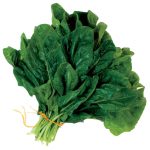 #1: Dark Leafy Greens (Raw Spinach)
#1: Dark Leafy Greens (Raw Spinach)| Magnesium in 100g | 1 Cup Raw (30g) | 1 Cup Cooked (180g) |
| 79mg (20% DV) | 24mg (6% DV) | 157mg (39% DV) |
Other Greens High in Magnesium (%DV per cup cooked): Swiss Chard (38%), and Kale (19%).
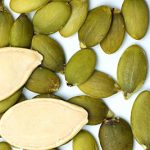 #2: Nuts and Seeds (Squash and Pumpkin Seeds)
#2: Nuts and Seeds (Squash and Pumpkin Seeds)| Magnesium in 100g | 1/2 Cup (113g) | 1 Ounce (28g) |
| 534mg (134% DV) | 606mg (152% DV) | 150mg (37% DV) |
Other Nuts and Seeds High in Magnesium (%DV per 1/2 cup):Sesame Seeds (63%), Brazil Nuts (63%), Almonds (48%), Cashews (44% DV), Pine nuts (43%), Mixed Nuts (39%), and Peanuts (31%), Pecans (17%), Walnuts (16%)
 #3: Fish (Mackerel, not goldfish. 😉 )
#3: Fish (Mackerel, not goldfish. 😉 )| Magnesium in 100g | Per 3oz Fillet (85g) |
| 97mg (24% DV) | 82mg (21% DV) |
Other Fish High in Magnesium (%DV per 3oz fillet (85g)): Pollock (18% DV), Turbot (14% DV), Tuna (14% DV), and most other fish at an average of 8% DV.
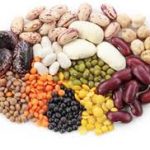 #4: Beans and Lentils (Soy Beans)
#4: Beans and Lentils (Soy Beans)| Magnesium in 100g | 1 Cup Cooked (172g) |
| 86mg (22% DV) | 148mg (37% DV) |
Other Beans and Lentils High in Magnesium (%DV per cup cooked):White Beans (28%), French Beans (25%), Black-eyed Peas (23%), Kidney Beans (21%), Chickpeas (Garbanzo) (20%), Lentils (18%), Pinto Beans (16%).
 #5: Whole Grains (Brown Rice)
#5: Whole Grains (Brown Rice)| Magnesium in 100g | 1 Cup Cooked (195g) |
| 44mg (11% DV) | 86mg (21% DV) |
Other Whole Grains High in Magnesium (%DV per cup cooked): Quinoa (30%), Millet (19%), Bulgur (15%), Buckwheat (13%), Wild Rice (13%), Whole Wheat Pasta (11%), Barley (9%), Oats (7%).
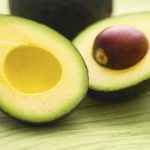 #6: Avocados
#6: Avocados| Magnesium in 100g | 1 Avocado (201g) | 1/2 Cup Pureed (115g) |
| 29mg (7% DV) | 58mg (15% DV) | 33mg (9% DV) |
An average avocado provides 322 calories, half a cup pureed contains 184 calories.
| Magnesium in 100g | 1 Cup (245g) |
| 19mg (5% DV) | 47mg (12% DV) |
Other Dairy Foods High in Magnesium (%DV per 100g): Goat Cheese (Hard) (14% DV), Nonfat Chocolate Yogurt (10% DV) and Nonfat Mozzarella (8%).
| Magnesium in 100g | 1 Medium (118g) | 1 Cup Slices (150g) |
| 27mg (7% DV) | 32mg (8% DV) | 41mg (10% DV) |
| Magnesium in 100g | 1/2 Cup (75g) | 1 Fig (8g) |
| 68mg (17% DV) | 51mg (13% DV) | 5mg (1% DV) |
Other Dried Fruit High in Magnesium (%DV per 1/2 cup): Prunes (11%), Apricots (10%), Dates (8%), and Raisins (7%).
| Magnesium in 100g | 1 Square (29g) | 1 Cup Grated (132g) |
| 327mg (82% DV) | 95mg (24% DV) | 432mg (108% DV) |
1 square of dark chocolate provides 145 calories.
Magnesium is arguably the most important mineral in the body.
“Every known illness is associated with a magnesium deficiency and it’s the missing cure to many diseases.”According to Dr. Norman Shealy.
Ok. I’m not sure about EVERY known illness but the point is still very valid.
Not only does magnesium help regulate calcium, potassium and sodium, but Magnesium (Mg) is essential for cellular health and is a critical component of over 300 biochemical functions in the body.
Even glutathione, your body’s most powerful antioxidant that has even been called “the master antioxidant”, requires magnesium for its synthesis.
Unfortunately, most people are not aware of this and millions suffer daily from magnesium deficiency without even knowing it.
Once thought to be relatively rare, magnesium deficiency is more common than most physicians believe. Here’s why:
[tie_list type=”checklist”]
[/tie_list]
Maybe, maybe not, it all depends on your risk factors and presenting symptoms which are covered in this article. Also, approximately 80% of people have low levels of magnesium so the chances are you are probably deficient.
Take note of this…only 1% of magnesium in your body is in your bloodstream, so often you can have deficiency and it would not even be discovered by a common blood test.
Many people may be magnesium deficient and not even know it. But here are some key symptoms to look out for that could indicate if you are deficient:
[tie_list type=”checklist”]
More and more health care professionals are prescribing magnesium supplements to help their patients. Restless leg syndrome is another warning sign of a magnesium deficiency. To overcome both leg cramps and restless leg syndrome you will want to increase your intake of both magnesium and potassium.
Taking around 400mg of magnesium before bed or with dinner is the best time of day to take the supplement. Also, adding in magnesium rich foods during dinner like spinach may help.
[/tie_list]
So who is most susceptible to a magnesium deficiency?
According to the National Institute of Health (NIH), not every one is created equal in regards to metabolizing and assimilating magnesium. In fact, certain people are inherently at a greater risk of developing Mg deficiency. Magnesium deficiency can be inherited genetically as an inability to absorb this important mineral. Also, a diet low in high magnesium foods, or even emotional or work stress can drain magnesium from the body. Whether inherited, through a deficient diet, or even stress, a magnesium deficiency can lead to side effects of migraines, diabetes, fatigue and more! The 4 most prominent at-risk groups include:
People with GI complaint, Type II diabetes, Elderly and people struggling with alcohol dependence.
Excessive drinking often experience Mg deficiency because of a combination of the reasons above. The easiest way to understanding this is to see alcohol as an “anti-nutrient.” It literally sucks the nutrients out of your cells, and prevents proper absorption/utilization of the vitamins and minerals that you consume. I would even go one step further and suggest that regular recreational alcohol use, not just alcohol dependence, can lead to Mg problems. Consuming 1-2 glasses of wine a week is fine for most people but much more than that is highly taxing on your liver. Alcohol can also deplete the minerals in your body because it causes dehydration, gut floral imbalance, immune system compromise, disturbed sleep patterns, and premature aging
So, what if you don’t fit in any of these buckets and you’re young, vibrant, and seemingly healthy? Does this mean that you’re off the hook? Not exactly.
Magnesium used to be abundantly present in most foods. However, in recent years food has less and less magnesium due to the farming practices and changes in growing cycles over the last century.
Studies have shown, for example, that the produce we eat holds a shadow of the nutritional quality that they did just 60 years ago.
According to a 2011 report published in Scientific American:
“The Organic Consumers Association cites several other studies with similar findings: A Kushi Institute analysis of nutrient data from 1975 to 1997 found that average calcium levels in 12 fresh vegetables dropped 27 percent; iron levels 37 percent; vitamin A levels 21 percent, and vitamin C levels 30 percent.”
A similar study of British nutrient data from 1930 to 1980, published in the British Food Journal, found that in 20 vegetables the average calcium content had declined 19 percent; iron 22 percent; and potassium 14 percent. Yet another study concluded that one would have to eat eight oranges today to derive the same amount of Vitamin A as our grandparents would have gotten from one.
The bottom line is that even if you eat a completely organic, non-GMO raw food diet, you’re still at risk because of soil depletion and our current capitalistic farming practices.
Even with this, you still want to make sure you are getting plenty of high magnesium foods in your diet and if you want a comprehensive list check out my article on the TOP 10 MAGNESIUM RICH FOODS.
If you think you might be more severely magnesium deficient and you want to improve your levels more quickly you may consider taking an all-natural supplement.
NOTE: Just as a reminder, when taking 600mg or more of magnesium, 20% of people taking magnesium as a supplement can experience diarrhea.
Kale, and cruciferous veggies in general, that you might be putting in your smoothies will make you warm. This is because, along with all the awesome benefits of this food group, they contribute to vasodilation.
Vasodilation occurs when blood vessels expand, allowing larger amounts of oxygen and nutrient-rich blood to the muscles of the body. What results is that wonderful feeling of skin and muscle swelling which is called the “pump” after an intense workout, or the “runner’s high” after an invigorating run.
There are several ways to increase vasodilation. As mentioned, intense exercise is the best way to open up your blood vessels.
However, for the elderly or infirmed who cannot participate in rigorous exercise, massage is used to better circulate the blood and increase vasodilation.
Or if you are an athlete that needs targeted/localized increased blood blood to promote healing… Essential oils are often used for this purpose which combines the beneficial elements of such natural ingredients as lemon, lemongrass, marjoram, cypress and myrtle, all of which have been used since ancient times to dilate capillaries and improve circulation.
Prescription vasodilators can also be obtained through a doctor, blah blah blah. Call if you need to.
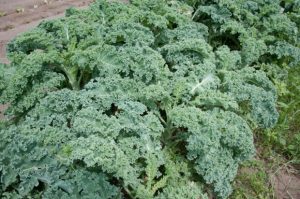 When it comes to exercise, vasodilation occurs naturally within the body. Nitric oxide is a powerful vasodilator and its effects are increased by eating foods rich in nitrates, flavonoids, L-arginine and other natural vasodilators.
When it comes to exercise, vasodilation occurs naturally within the body. Nitric oxide is a powerful vasodilator and its effects are increased by eating foods rich in nitrates, flavonoids, L-arginine and other natural vasodilators.
Nitrates are contained in such foods as spinach, leaf lettuce and beets. When eaten, the saliva in the mouth turns natural nitrates into nitrites which then get swallowed and arrive in the stomach where nitrite is converted into nitric oxide by gastric acid. Nitric oxide is then used by the body to relax and dilate the walls of blood vessels.
Flavonoids play another key role in producing nitric oxide and can be found in foods like broccoli, spinach, kale, hawthorn and dark chocolate. Flavonoids magnify the effect of nitric oxide synthase which is the catalytic enzyme used in nitric oxide production. Therefore, flavonoids increase the activity of nitric oxide synthase which, in turn, increases the amount of nitric oxide produced by the body. The more nitric oxide coursing through the body, the more dilated the blood vessels become.
The amino acid L-arginine is another powerful vasodilator which research is finding is used by the body to assist with the synthesis of nitric oxide. Natural food sources which supply L-arginine are red meat, chicken, fish, cheese, milk and eggs. You can also obtain it from almonds, walnuts and cashews.
Check it out! 2014 has come to a close. And here we are, celebrating 2015. And you know what!? I’m crazy excited. I’ve got some big plans for myself. Can’t wait to see how it all shakes out.
I’ve been working on my dream board. Wishing. Dreaming. Having a blast.
And I CAN NOT believe what a year 2014 was. When I slowed down a bit to take a ganger at the year. OMG! Have you done that? Have you stopped to think about all the things you accomplished?
Is there a list of carry overs?
Hey, that’s ok. If you’re like me…I set goals like I’m a hungry girl in the store. There is always too much in the end. But that’s how I roll. I plan big, go for all I can think up. What ends up happening is always super crazy awesome. The left overs, I move to the next year. No biggie (And if you find that you have the same left overs year to year, well, that’s something to think about, get help on)!
I wanted to give you something to think about before you set your goals.
What makes you CRAZY HAPPY!?!?!
Write it down. The color blue. Birds eating out of the feeder on the porch. Good home cooked food. Sunsets. Facebook posts about friends having a blast. Pig vidoes. Warm kisses in the morning. Little boy hugs. Cuddling with the dog.
WHAT MAKES YOU CRAZY HAPPY!?!?!?
I challenge you ROCKSTARS out there to make a list of 50 to 100 things that makes you happy.
Then work to set some goals.
READ THIS: These goals work manifest much easier if they align with what makes you CRAZY HAPPY!
I AM SENDING YOU ALL A BIG FAT HUG!!!
You’re the best!
[amd-zlrecipe-recipe:4]
Although the brain is such a complex organ, determining who we are and how we navigate our way through this world, its maintenance and care doesn’t have to be complicated. Just keep these basic facts in mind:
Choose whole grains and legumes for sustained energy release too, and your brain will enjoy optimal energy supply. A wide variety of fresh produce will also supply vitamins and minerals that your brain needs to function optimally.
A great green drink, full of nutrient-rich compounds, can help to get your blood glucose more stable, and lead to less cravings. Eating the right fats helps immensely too, because when they are supplied with the right fats, your cells produce energy more efficiently. This keeps your energy levels high, which leads to less energy slumps and chocolate-fixes.
As it’s best to eat only after you’ve been awake for about an hour, it may pay you to prepare your breakfast, and eat it when you arrive at your destination. It sure beats a cup of coffee and a muffin at your desk. Otherwise, you can go to bed earlier, wake up in time to exercise, and then eat your breakfast.
These tips may take some time to implement, but even changing only one to start with is a move in the right direction.
Delia McCabe lost her enthusiasm for the “talking cure” after completing her Master’s degree in Psychology. She had discovered that what you eat affects your brain function and that until the brain is properly nourished, no amount of talking will get it working properly. With the brain being 60 percent fat, Delia decided to devote her time to extensive research into the biochemistry of fats and oils. She wanted to understand what kind of fats the brain requires to function optimally. She discovered how toxins and fats are linked and how your cells work poorly when exposed to toxins and suboptimal nutrition. Her research led her to study how poor nutrition exacerbates stress and impacts mental health. Delia’s goal is to arm people with the knowledge they need to minimize their stress and help them live their lives optimally through feeding their brains correctly. She developed a unique step-by-step plan to help them modify their eating habits without adding stress to their lives. Her motto is “Feed Your Brain, Change Your Life”.
Source: DeliaHealth
[amd-zlrecipe-recipe:5]